How To Convert A Shed Into A DIY Goat Barn
Get tips from this guide on how to convert a shed into a DIY goat barn. A great way to take what you have and turn it into what you need.
The first thing to have when learning how to raise dairy goats is shelter. Use what you already have and turn it into what you need. A DIY goat barn that you can use for years to come.
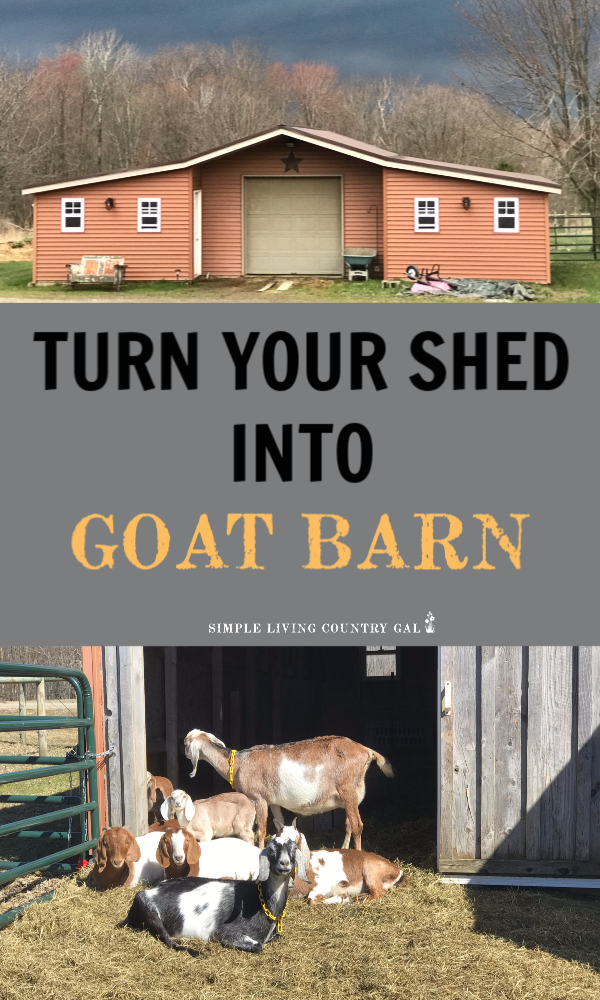
The main goal when housing any type of animal is to protect them from the elements and this will be different depending on where you live. Whether it be from the rain, snow, cold temperatures, wind, or the sun’s heat. All animals need a place to go that will give them a break from any excessive weather.
What types of shelter do you need for goats?
There are a few options you can use to shelter your goats, and the one you choose will all depend on the weather where you live and the number of goats you have.
Option #1. Three wall set up
If you live in a milder area with warmer temperatures year round, a lean-to (AKA a shelter with only three sides) will probably be enough to house your goats. It will provide shade from the sun, keep them dry in the rain, and allow them to come and go as they please.
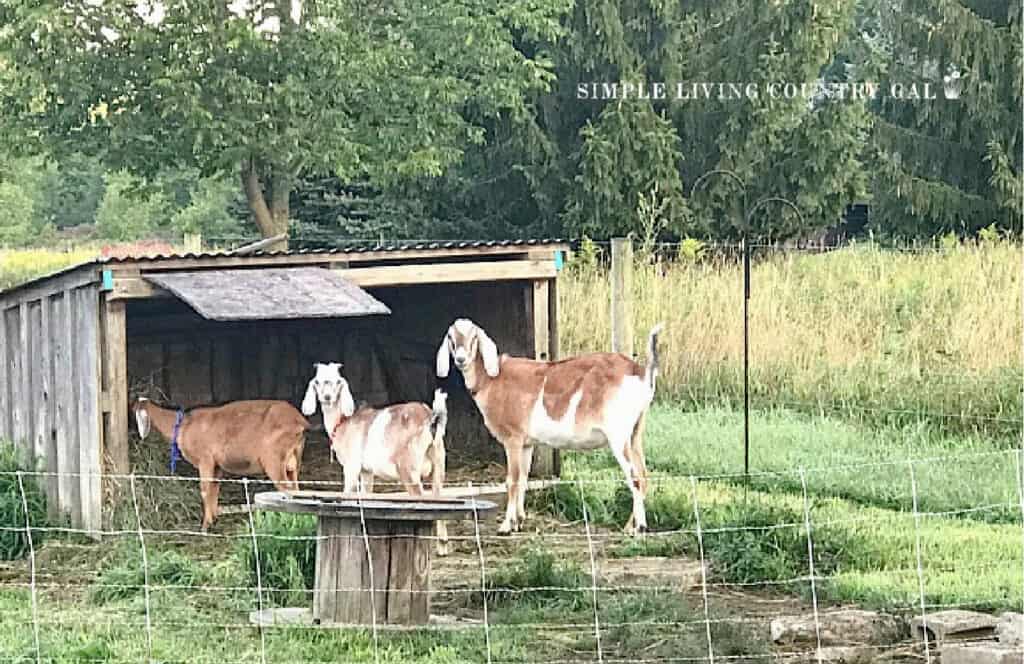
Option #2. Four Wall Setup
If you live in a more severe climate area such as Northwestern Pennsylvania, as I do, you will want to have more protection for your herd, meaning four walls. This will allow you to close out the weather and keep your herd dry. We do not have a barn so much as we have a shed that we converted into a barn. The nicest part is we were able to design this barn into one specifically built to house goats.
Do you need a barn to raise goats?
When folks ask me about getting started with goats, the first question that comes up is, “Do I need a barn to raise goats?” While a goat barn would be ideal, it is not necessary.
When we first started raising goats, we fully intended to build a barn on our homestead, but we quickly found that we had a small issue with that plan: a lack of funds.
Building a barn is expensive—really, really expensive, and right before we were ready to break ground on a brand-new barn, we were hit with a few financial bullets. This is usually how things work for us, and luckily, we were able to cancel the barn building. We went back to the drawing board looking for another option.
After taking a walk one Sunday afternoon, Hubs pointed to our large shed and suggested we convert it into our barn. This would save us a lot of time, not to mention quite a large amount of money.
I wish I had a before photo of our shed, but it was only the middle section without either side addition. After getting our first goats, we added one side and the other as our herd grew. These two additions allowed us to triple the size of our original shed, turning it into our goat barn.
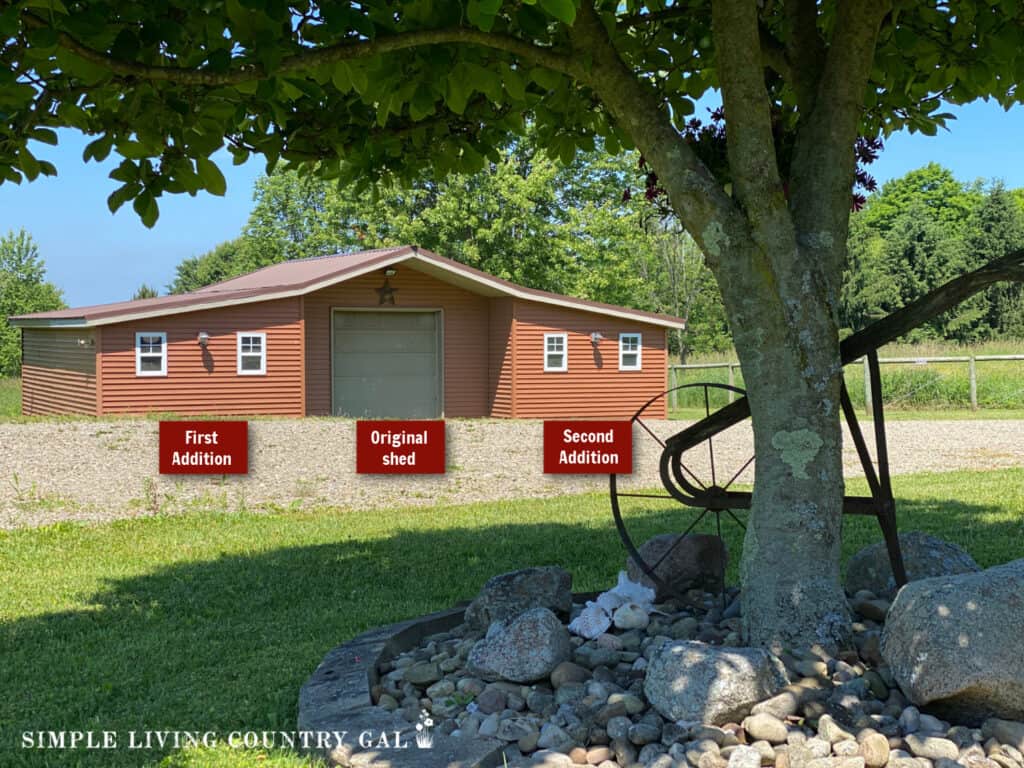
Where to locate your goat’s shelter
The location of the shed we chose to house our goats is pretty close to the house. This was not what I wanted starting out, but as with all things in homesteading, you learn to pivot and change plans. Even though I was worried about smells and mess we pushed on with the update. Now, more than a decade later, I can say it was the best decision we could have made.
With the barn so close to the house, doing chores is much easier. I can walk to our barn, which means I can get out there quickly if there is an emergency.
Hiring a Crew
We usually do our own construction work, but this project needed to be done quickly, so we decided to hire the job, and we hired a local Amish crew to build both of our additions. One was added in the first year, and the second was added in the next.
What is the purpose of the barn?
When Hubs and I designed our DIY goat barn project, we knew we wanted to raise goats and pigs, with goats being our main focus. Planning plays a large role in any project, especially one this size. Know the purpose of your barn before doing any major construction to ensure you have the right size limiting the need to add on later.
Planning will also help you to create a setup that will work going forward. Research the animals you will be raising and how much space they will need to have without begin overcrowded.
How much space do goats need?
After our own research, we found a few things held true. Goats need room to move around inside a barn, especially if the weather is cold and rainy, keeping them inside for an extended period of time.
A general rule is that most goats require about 10-15 square feet of indoor space. Since we planned to raise a larger breed of goat, Nubians, we decided to go a bit larger to ensure they had enough room.
More Goat Breed Resources:
Once we had an idea of how much space we needed, we used that number as a guide when planning out the additions.
Visit other barns in your area
If you are brand new to raising animals and you live in an area where others raise livestock, make a phone call and ask to tour their setup. I did this with several farms and learned more from those visits than any book, online blog, or forum.
Seeing firsthand how someone has their barn layout setup gives you a unique insight that is invaluable. And folks LOVE to show off their farms, so don’t be afraid to just ask. 🙂
Not sure what goat breeds will best fit you, your setup, or your family? You can jump over to my resource page and get the breakdown of each breed of goat so you can make the best choice.
READ: CHOOSING THE BEST GOAT BREED
What to include in a goat barn
Let’s discuss the different parts you should consider having in your goat shelter. I hope this list will help you determine what you need and see if it will work with any of the structures you have now.
This is a list of important parts of a goat-raising setup, but not all are required. Just know that the more you can include, the easier it will be to raise your herd for years to come.
#1. communal area
Over the years, I have found it is best to have a large open area to house my herd as a group. This encourages the goats to get along and establish a hierarchy in the herd safely, as there is more room to move around.
Your goal with goats, or any livestock, for that matter, is to ensure they have enough room and are not overcrowded. This is even more important in the winter when your animals will be closed up for longer periods of time.
For our barn, we added two large and open communal sections, one on each side of our shed. They are each 14′ x 24′ and can easily house up to 4-7 full-grown large breed goats if needed. Having two communal areas is nice but not necessary.
Why we have two communal areas in our barn
I like to have two open areas because I find it a helpful way to regulate breeding more efficiently. Since we have two bucks, we can split the herd, keeping inbreeding to a minimum.
Another reason why I prefer two open areas is I can keep younger doelings together as I wait for them to join the main herd. Since it is recommended to not breed doelings under the age of 10 months, having them in a separate area allows them to mature before being bred.
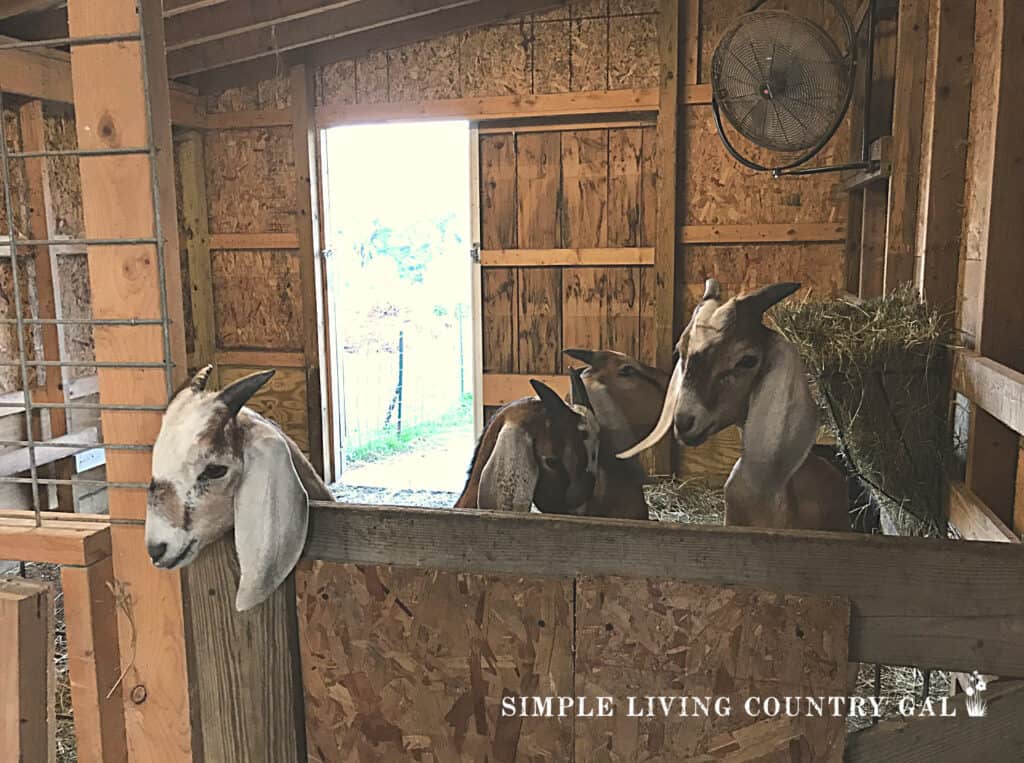
#2. separate stalls
Having stalls in a barn is a great way to manage your herd and their health. Let’s look at a few reasons why you may want to include them.
Sickbays—Separate stalls for injured or sick goats will allow them to get healthy more quickly. Sickbays are also nice to have if you have a goat that is being picked on or bullied, and you want to get it away so it can catch its breath a bit.
This will allow them to strengthen up before going back in with the herd. More often than not the bullying will continue but you can at the very least support your lower-ranking goat until they are strong enough to fend for themselves.
Birthing Pen – On the same note, having a stall for does who are kidding gives them a safe and private area to have their kids, eliminating undo stress to the mother. You can read how to set a kidding pen up here.
How we recently used our sickbay area
I am breeding at the time I am writing this, and that means my buck is a bit more aggressive than usual. To ensure he is the only one breeding the herd, he will push out my wether, Peanut. Since I have a place to keep Peanut, I am able to safely pull him out of the herd and house him while we are breeding.
Once breeding is done, my buck will go back to his docile self allowing me to return Peanut to the main pen.
When you have a sick goat for any reason, it is vital to get them out and separate them from the rest of the herd. This will keep any sickness from spreading and give you a more hands-on environment. Medicating a sick goat is much easier in a small pen than in a big open area.
Since the original shed had concreted floors, we put the sickbay stalls and birthing pens in this area. The concrete flooring is much easier to keep neat and clean.
Each pen measures approximately 5’x7′ with the interior walls screwed in, so we can remove them if needed. This is helpful if you have a few goats you want to pull out for a certain time frame and you want to ensure they have enough room.
In our goat barn, we have five pens set up that I can easily remove interior walls and add additional sections if needed to make them either larger or smaller depending on what I need them for.
For goat sickbays, you will want to make sure to reinforce your pens. Goats like to be up and will stand on the fence so they can see more easily. For this reason, you will want to reinforce your sides with corner braces giving additional support.
When building your goat shelter, use supplies that are durable and sturdy from the onset. This will be a costly investment at first, but it will save you money in the long run. Sturdy locks, concrete flooring, durable wood, and framework are all crucial to a good livestock shelter.
SLCG PRO Tip: It is best to make things adjustable when creating your setup. I learned early on that what I thought would work didn’t, and I needed to change things up. Setups need to work not only for your animals but for you as well. Be open to changing things (more than once) until you find what works best.
#3. Milking Stall
If you have dairy goats, you will want to dedicate a stall that you can use for milking. When you milk a goat, your main goal is to keep things neat, and I have found over the years the best way to do this is to have a dedicated area just for milking.
Most barns I toured before we began building had separate milk houses, but our budget could not handle that. Instead, we converted one of our sickbay stalls into a dedicated milking area. This stall is close to the main area, so the goat I am milking can still hear the herd. This helps to keep the goat on the milk stand free of stress.
Do you need to have a milking parlor?
No, you do not need a separate room or stall to milk your dairy goats. I have seen plenty of setups where milking is done in a corner, in the aisle way, or even outside. There are a few reasons why you may want to have a dedicated milking space.
- Weather – If you live in an area where weather plays a large role in how you do things, you may want to setup an area just for milking.
- Age – Older folks need to consider a few more things when setting up a barn. Having a space where I can sit down and milk without distractions is easier on my back and hands.
#4. Hay Storage
You may want sufficient space to hold hay for the cold seasons. I learned early on that the more room you have to store hay the fewer trips you will need to make. Getting hay is a hard job, and having space to store a few month’s worth is really helpful. Each winter we convert 3 stalls into storage space for our winter hay supply.
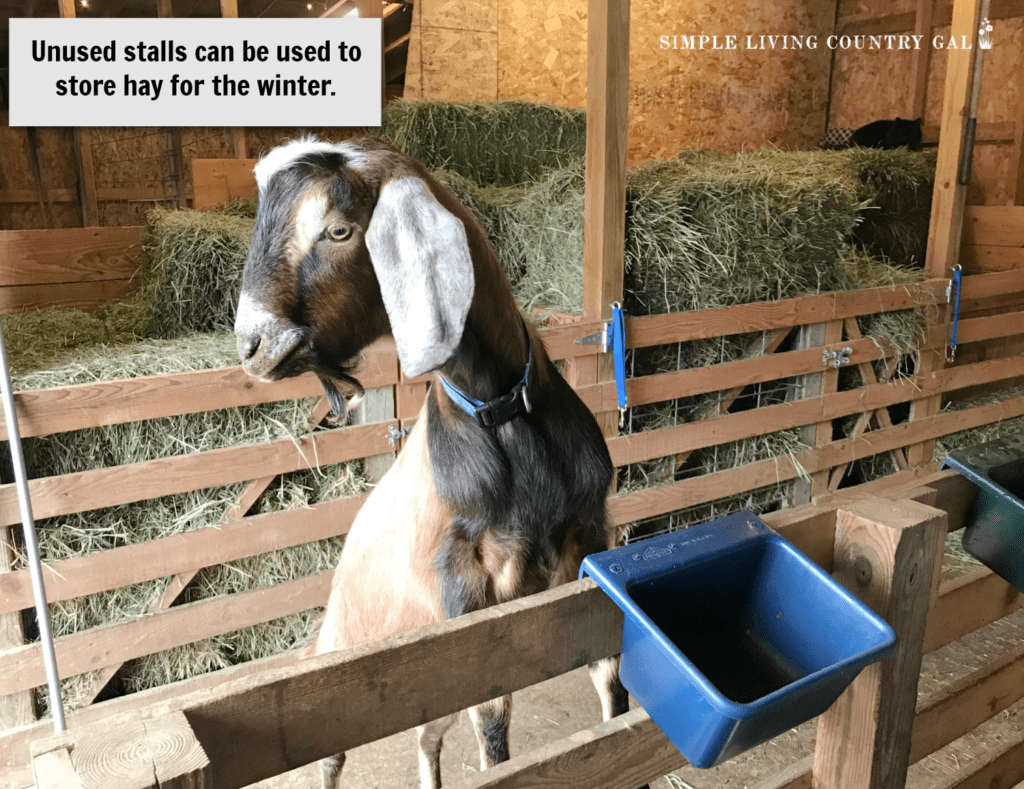
How to Store Winter Hay in a barn
When storing hay, be sure there is good airflow. This will keep the hay dry and free from mold. It is extremely important never to give your goats any hay that has mold. This will not only make them sick but could potentially kill them. Keep hay protected from the weather and dry at all times.
If you are not sure if your hay is moldy, you can smell for any off or foul odors. Hay should smell like grass; the better the hay, the fresher the smell. If you smell dust that is okay, the point is not to smell foul odors.
In the beginning, we did not have the space to hold more than a few bales of hay. That meant we had to go out and buy hay weekly, which got old pretty quickly, especially in the winter. Now that we have the room, we can stock up, and this has been a game changer for us.
#5. Feed Room
Although not necessary, a feed room is nice to include if you have room for it. We were able to convert a back section of our shed into a feed room for all our livestock.
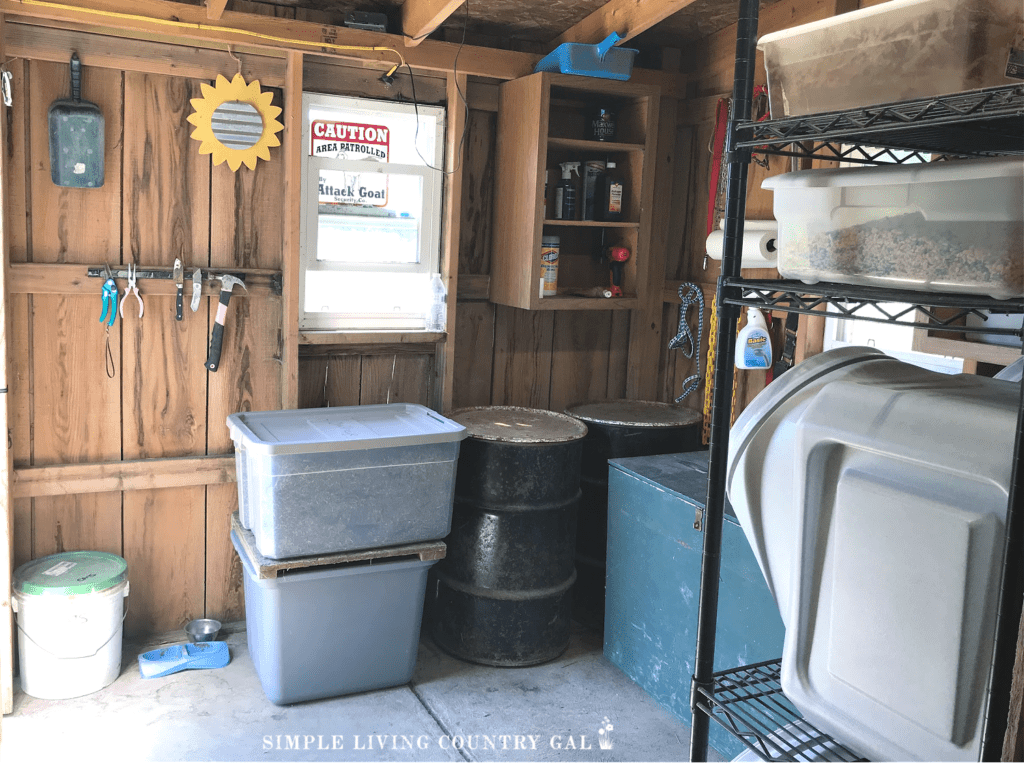
This space allows us to keep all the feed secure and out of reach from the goats. We added a few old cabinets where we can store medications, herbs, minerals, grooming supplies, tools, and even my trusty stash of zip ties.
I have a pen-style gate on the feed room with a sturdy lock to keep the goats out just in case they get out of the main pen.
SLCG PRO TIP: ALWAYS be one step ahead of your goats. A gate to a feed room is a perfect example.
Don’t think your goats won’t escape a pen because they will. Having a second line of defense keeps my feed room free from my mischievous crew. Bloat is a severe and deadly disease that can occur if your goat gets into any feed. For that reason, you will want to do all that you can to keep that feed locked up tight so you do not risk injury to your herd.
HOW TO SET UP AN ORGANIZED FEED ROOM FOR YOUR ANIMALS
All of our minerals and feed is stored in very sturdy containers or bins. This is just another step I take to keep rodents, chickens, and goats out of my feed.
#6. Sunning area
We live in a very wet area, so keeping goats here is a bit tricky, meaning we need to take extra precautions to keep them healthy. I learned quite quickly that letting my goats onto a wet pasture is a big No-No. For that reason, we have an enclosed small outside section that can be opened up to the main pasture.
This gives my goats access to fresh air and the sun without being on wet grass. To help even further, we have a layer of gravel down that keeps the water away from our goat’s hooves. Not too easy to keep clean, but our goat’s hooves are in much better shape, so it is a good tradeoff for where we live.
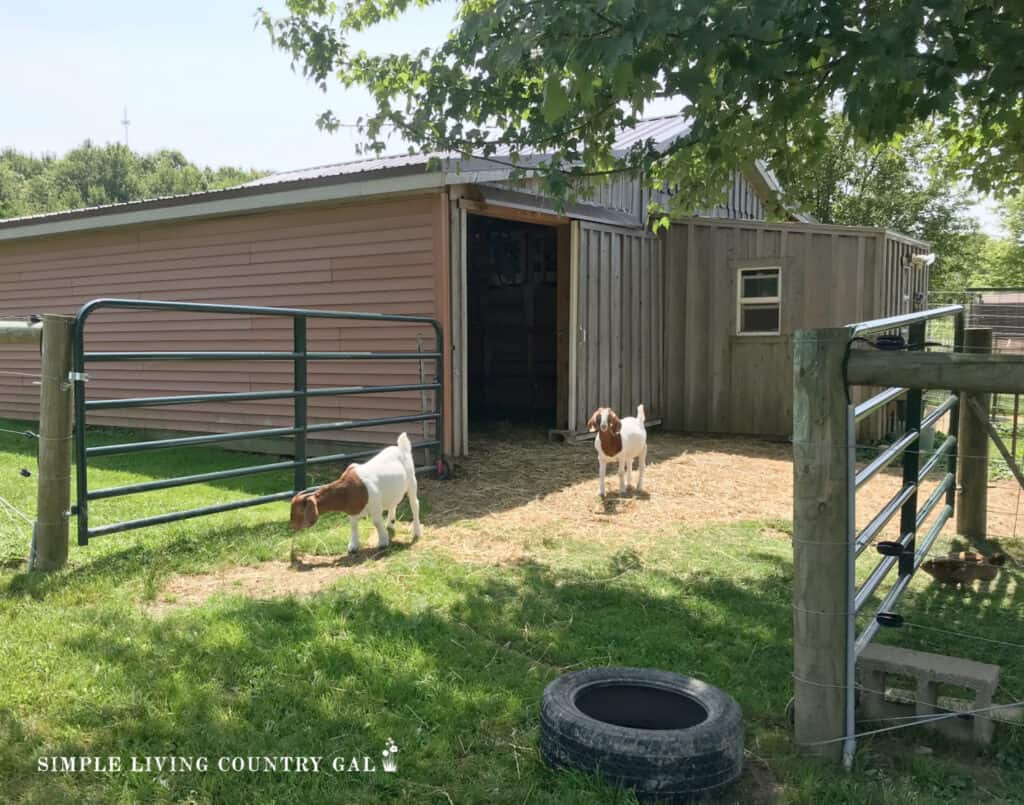
These fenced-in areas are approximately 10′ x 14′ and just enough for them to lay in the sun, which they like to do quite often. Once the morning wetness has dried off, we let our herd outside to pasture.
If you live in a continually wet area, you will want to keep your herd off pasture until the dew has had time to dry off. This will do a lot to keep your herd worm free. You can also implement a routine of herbal wormers to help build up your goat’s resistance and keep work infestations to a minimum.
HOW TO TRAIN YOUR GOATS ON ELECTRIC FENCING
Bonus Tips for Goat Barns
Let’s look at a few other things to keep in mind with your goat barn or shelter.
Tip #1. Keep your barn or shelter facing away from the wind.
If you are starting from scratch, this tip is extremely important. Make sure your main opening opens away from the wind. This will keep your shelter warmer and the snow from piling up daily in front of your entryway. Another chore I will do all I can to avoid.
Lucky for us our shed already faced the ideal direction. This has really kept the inside of our barn in much better shape.
Sadnyy 10 Pcs Ox Tendon Feeder Pan, 3 Quart Feed Pan Utility Horse Feed Bucket Rubber Dog Bowl Horse Feeder for Cats Dogs Goats Horses Chicken Dust Bath Container Animal Feeding, 10.2 x 3.1 Inch



Tip #2. Location, location, location
When you are looking for a place to house your goats keep in mind the distance from your home. Remember you will have to haul feed, possibly water, milk supplies, and other items out each time you have to do chores.
Keeping things closer will be much easier for you. Because when you have animals, and you are new to raising those animals, you will find yourself checking on them constantly. When your barn is just 30 feet from your door, this will make checking on them much easier.
Nothing proves this more than when you are in birthing or kidding season. I was in my barn every hour during the coldest months of the year. Thank heavens our barn was close, and this wasn’t that big of a bother. But if we had put our barn in its original location (over a thousand feet away), I would have needed to use the 4-wheeler just to get there more in the snow.
More Goat Kidding Resources:
The final location is essential and something to remember when scouting an area for your goat shelter.
Tip #3. Routine Shelter Checks
Get into the habit of checking structures routinely on your farm or homestead. This will alert you to any issues so you can correct things before they get too out of hand. Fencing, sickbays, roofing, etc., are all parts to check and repair as soon as you see an issue.
All in all, DIY goat barn project ended up being the perfect solution for us. The cost was just a fraction of a full barn construction, the time was days to construct rather than weeks to months and we could still tailor our setup to fit us and our animals the best and most efficient way.
When housing your animals, keep in mind the climate, the types of animals, their heartiness, and finally, your financial situation. Finding a solution that will marry all is your main goal. To do this, you may need to think outside of the box. Look at your property and what you have to work with.
A full barn and even a shed is not a requirement for raising goats. You can use a lean too or convert any building into a pretty amazing and useful shelter. See what you have a try to make it work. Keep them warm, dry, and free from the wind and cold and hot direct sun and you will have healthy, happy, and productive animals.
Do you have your own DIY goat barn? If so comment below and share a picture, I would love to see it!
MORE GOAT RAISING RESOURCES:
- Turn an Old Shed into a New Goat Barn
- Build a DIY Goat Playground
- The Key to Great Tasting Goat Milk


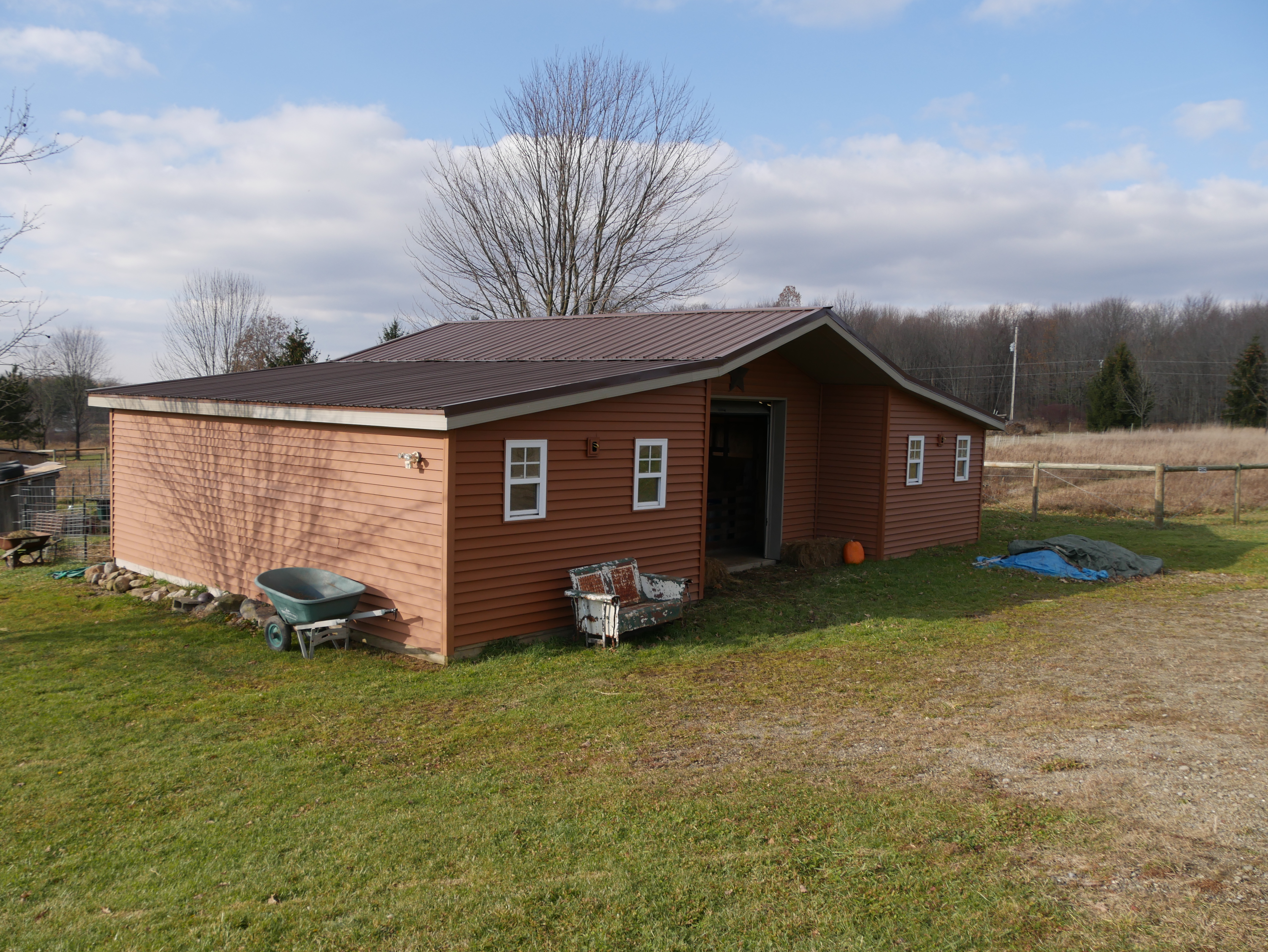
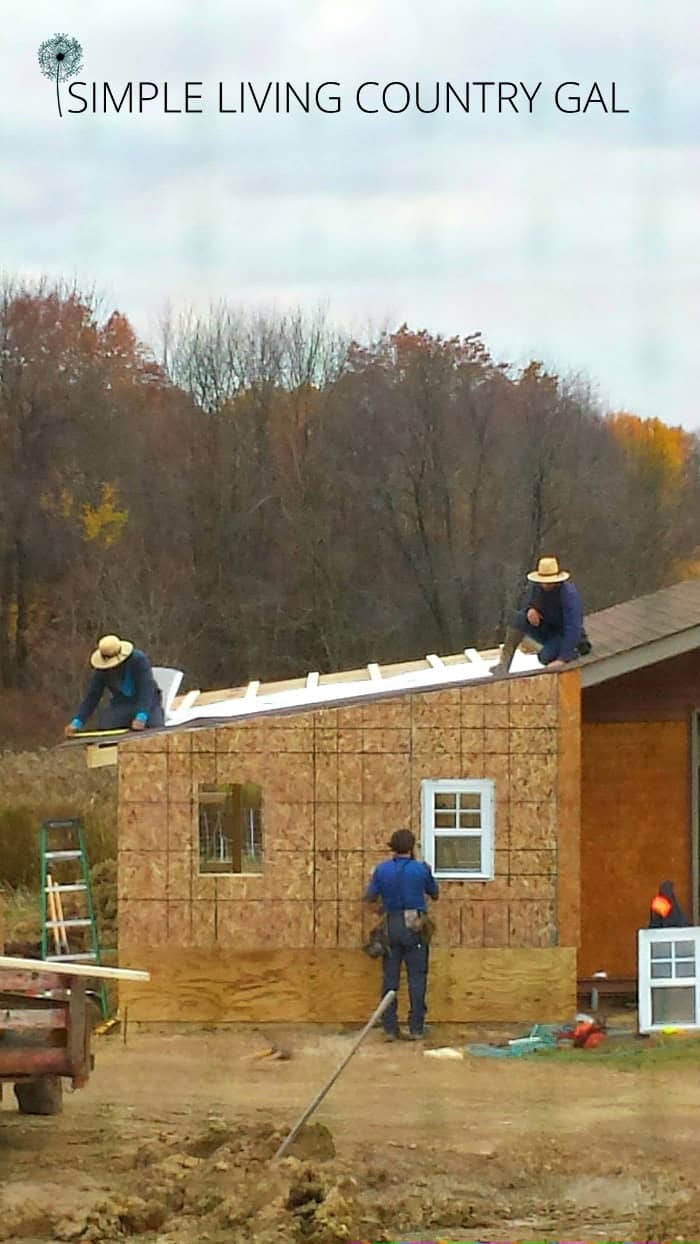
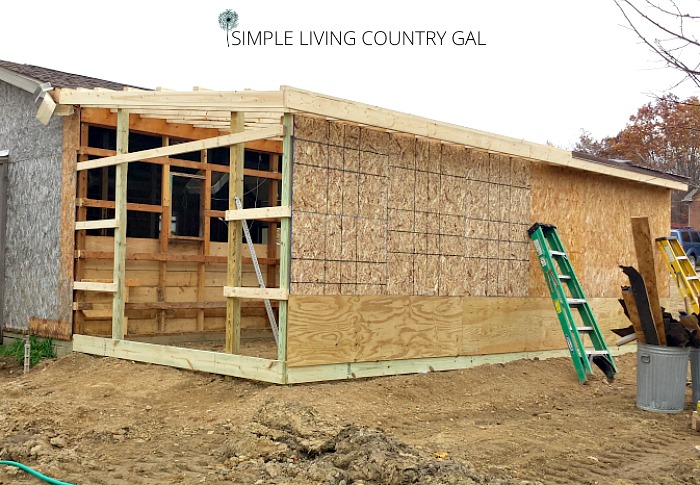
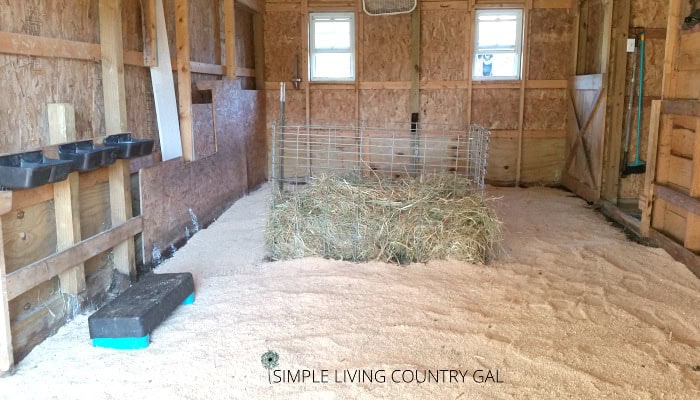
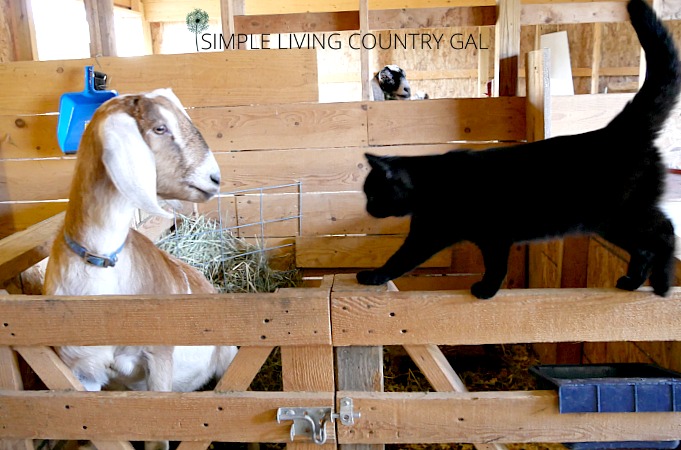
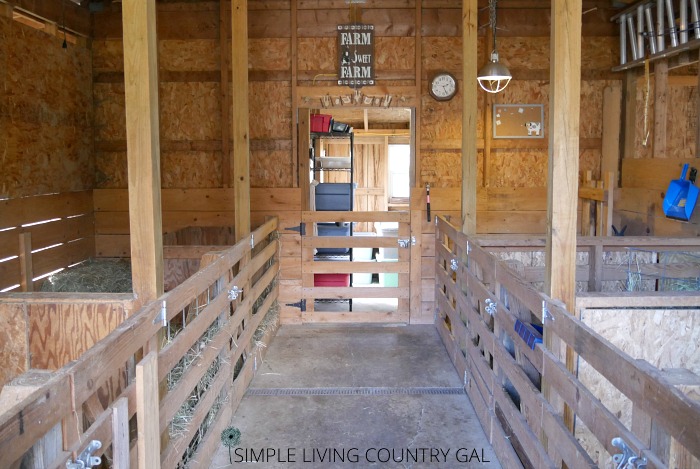
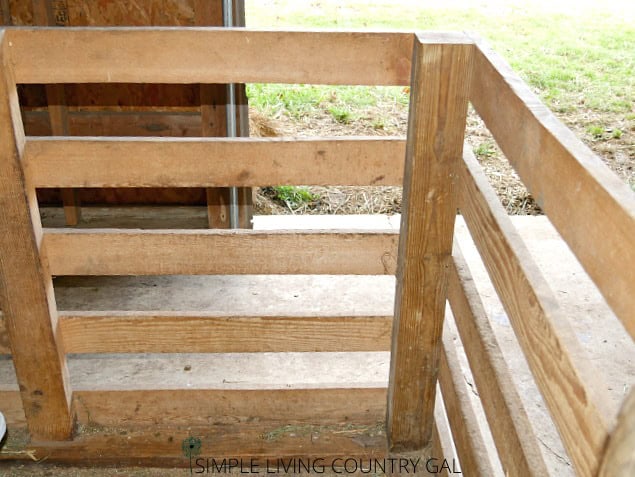
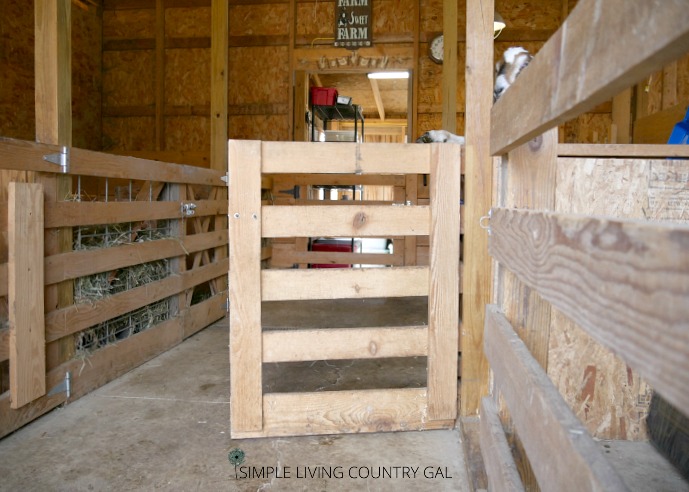







Hi, Tracy!
I just entered the giveaway, and congrats on your first one! (I have still not done a giveaway yet–not sure what exactly to do)! I submitted 2 entries, and I wanted to let you know that when I clicked to make a comment, the page wasn’t valid. So here I am: commenting!
Great article too! We need to make more space for our goats–as we’ll have babies joining us soon! Your goat and black cat look just like two of our family members over here! 🙂
Not sure if you remember me: We met briefly at the Activate conference! Have a very awesome day and a beautiful holiday!
Heidi
I sure do remember you, Heidi!
Well, I just knew I wouldn’t get through this thing without at least one glitch! I will have to see if everyone else had troubles as well. Thanks! When you are ready to do yours, please let me know!
Tracy Lynn
That shed is about the size of my house, lol! just kidding, but it’s a beautiful size. Great inspiration here. It turned out just beautiful. Thanks for sharing your ideas on the Homestead Blog Hop. Hope to see you again this Wednesday. 🙂
Hi Kelly,
Thanks for stopping by!Yes, the shed is kinda big….but I warned Hubs, if he builds it, I will fill it! haha 🙂
Tracy Lynn
How big was the initial shed? I have a 10’x10′ shed that I want to use as a starting point. I am going to be getting Nigerian Dwarf Goats this Spring and an trying to figure out how to convert it.
Hello, Tabbatha,
That shed is large, roughly 20 x 18, but if you only have a few goats then 10 x 10 should work just fine. As long as they have plenty of room to move around in and you are able to keep up with the cleaning you should be good to go. Now, with that being said, if you live in a cold climate where your goats will be more in the shelter than out, you may want to only keep 2 in that shed.
I hope this helps,
Tracy Lynn
Do you like the concrete floor? I will be building a goat barn and am going back and forth on what to use for the floor. We are also in an area (in Florida) where the ground holds moisture if it rains for several days in a row. I was thinking a layer of sand to allow urine to pass through to the ground and give the goats drier footing. But my other choice might be cement/concrete. Does it absorb urine and stink?
I do and I don’t. It is good for our birthing stalls, but the main stall we have is dirt, and that works best there. Concrete means you need to clean more frequently than you do in a dirt pen as the ground absorbs some of the moisture. One of our pens we tried a layer of gravel and that does help.
I’m new to goats and currently building a shed for them. We live in Canada so colder climate. I’m wondering if it should be insulated? Also, your “sick bay” what would dimensions be? Thank you for sharing.
I do not think you need to have your barn insulated for your goats, but you may want to have an area that is insulated for you. It gets awfully cold here as well, and having a feed room that I can warm up in really does help especially on those long kidding sessions that always tend to happen on the coldest days of the year.
Our sick bays are 5’x4′ but we have the inside wall that can be removed if we need a bigger area.
I hope this helps!
Tracy Lynn
Hi there…My name is Amy and I am in the process of converting my horse stalls into goat stalls and milking station. I will be a new goat mom and I pick up my two doelings and my buckling in April and the more I read the more nervous I get. What worries me the most is…Do I keep my boys and girls separated ALL the time? If I have to do this then I feel I need to also get a wether to keep him company.
I was also going to purchase A Donkey for protection (we have many coyotes) but this seems futile if the Donkey is with one or the other or separated by fence??? Do you put your goats to bed in the barn every night? I could make two communal areas and displace my milk station for now to give them different areas…HELP!
New Texas Mom…Amy
Hello, Amy!
Yay on your new goat adventure, you are sure to have some fun days ahead. 🙂
First off, yes you will need to keep your buck away from any does you do not want to get pregnant. I prefer to wait until 12months of age before breeding our does, this just ensures their bodies can handle the rigors of kidding. If your goats can share a communal fence you will not need a wether. Also, it all depends on your goat. Our first buck was just fine being all alone until breeding season began.
If you do decide to get wether, sooner is better than later so your boys get used to being together early on. Remember, that once rut gets here, your buck will not want your wether around. So keep that in mind as well.
Where we live we have coyotes, and loose dogs, and that means yes my goats are put into the barn each night.
Having a donkey is still a good idea.
Here is how we breed.
Buck and wether are in an outside pen with a lean-to for shelter from May-October. We then put the goats together that we are breeding. The wether and doelings are put into a separate area during those months. So, we have 2 communal areas inside of our barn for this reason.
I hope this helps!
Tracy Lynn
Love your article. I am not quite looking to raise goats quite yet, but love your idea for my daughter who shows goats (and soon lambs). I would love to see a floor plan if there is one available. I would love to know what you did for your pigs (we have a potbelly) also. I believe what you did fits what we can do on our property.
Hi, my husband and I are rebuilding our goat pen to accomodate future goats. We are in Jamaica, and with lots of grazing areas around us. As the pen goes up, 20×18 with an approximate stall count of 10 stalls, is there anything you can suggest we do to improve our new pen? We have taken the pen up, off the ground 4 feet…. Very large indeed I must say, but looking really good. Our goats, from 3 mother’s, in 8 months have given us 10 kiddies. 1) 4 drop, 1), 3 drop, 1) twin, and 1) 1 single. All healthy. 3 boys and 7 girls. And that’s not counting the 8 others, including 2 rams. Any suggestion helps.
sounds like you will have a great setup!
My best advice is to be sure you have a secure place to keep your male goats (bucks) when you are not breeding. This will keep those accidental breedings from happening.
Also, goats are herd animals so keeping them all together is a great way to encourage herd contentment. Stalls are perfect for sick animals, kidding animals, or quarantining new additions.
Good luck!
Tracy Lynn
If you did get to pick the barn location how far would you want it from the house for your goats?
I would keep them close enough so you can milk them and do chores without having to use a 4wheeler or other vehicle to get to the barn or shelter.